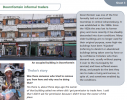Land Library
Welcome to the Land Portal Library. Explore our vast collection of open-access resources (over 74,000) including reports, journal articles, research papers, peer-reviewed publications, legal documents, videos and much more.
/ library resources
Showing items 1 through 9 of 269.Much of Nigeria's recent economic growth can be attributed to its non-oil economy-primarily agriculture. But the recent agricultural growth has been driven mainly by expansion in areas planted while productivity has remained flat or declining.
The young man was scared. The city government had instructed him to count the shacks in the settlement. He arrived smartly dressed carrying a briefcase and clipboard with pen in hand and a list of the shacks. His job was to find any new shacks without the official number painted on the door.
The main purpose of the Guidelines is to provide a holistic approach to addressing land issues from the immediate aftermath of a natural disaster through early recovery and reconstruction phases. It is targeted at humanitarians and land professionals, as well as government officials.
Tribal land management constitutes the largest of the three main tenure types that prevail in Botswana (tribal, State, and freehold). The land inventory is a means to support land administration, land development, land use planning, land transactions and natural resources management in Botswana.
This publication provides an overview of some the most important land-related environmental and climate change problems that the world is facing. land, Environment and climate change offers an overview of the relationship between land tenure, land management approaches and the environment.
Most developing countries have less than 30 percent cadastral coverage. This means that over 70 percent of the land in many countries is generally outside the land register.
We investigate the impacts of sustainable land management practices on soil carbon stocks and also impacts of soil carbon on the mean and variance of crop production using econometric tools.
This case study draws on research that investigated how urban land is claimed, used or divided and the various land use management (LUM) practices that exist around these various and sometimes competing land uses.
These guidelines introduce and promote the essential elements of participatory rangeland management (PRM). Based upon the successful experiences of participatory forest management, the guidelines provide a process following three stages of investigation, negotiation and implementation.








